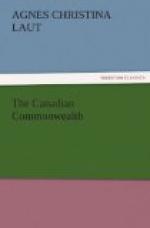Hopelessly at sea as to the cause of the continual unrest in her colonies and undoubtedly sad from the loss of her American possessions, England now sent out a commissioner to investigate the trouble; and it is to the findings of this commissioner that the United Kingdom has since owed her world-wide success in governing people by letting them govern themselves. People sometimes ask why England has been so successful in governing one-fifth of the habitable globe. She does not govern one-fifth the habitable globe. She lets much of it govern itself; and it was Lord Durham, coming out as Governor-General and high commissioner at this time, who laid the foundations of England’s success in colonizing. His report has been the Magna Charta and Declaration of Independence of the self-governing colonies of the British Empire.
First of all, government must be entrusted to the house representing the people. Second, the granting of moneys must be controlled by those paying the taxes. Third, the Executive must be responsible not only to the Crown but to the representatives of the people. It is here the Canadian system differs from the American. The Secretary, or Cabinet Minister, can not hold office one day under the disapproval of the House, no matter what his tenure of office.
The Act of 1840 resulted from Durham’s report. Upper and Lower Canada were united under one government—which was really the forerunner of confederation in ’67. The House was given exclusive control of taxation and expenditure. Nothing awakened Canada so acutely to the necessity of federating all British North America as the Civil War in the United States, when the States Right party fought to secede. Red River and British Columbia had become peopled. The maritime provinces settled by French from Quebec and New England Loyalists were alien in thought from Upper and Lower Canada. The cry “54-40 or fight,” the setting up of a provisional government by Oregon, the Riel Rebellion in Manitoba, the rush of California gold miners to Cariboo—all were straws in a restless wind blowing Canada’s destiny hither and whither. Confederation was not a pocket theory. It was a result born of necessity, and the main principles of confederation embodied in the




